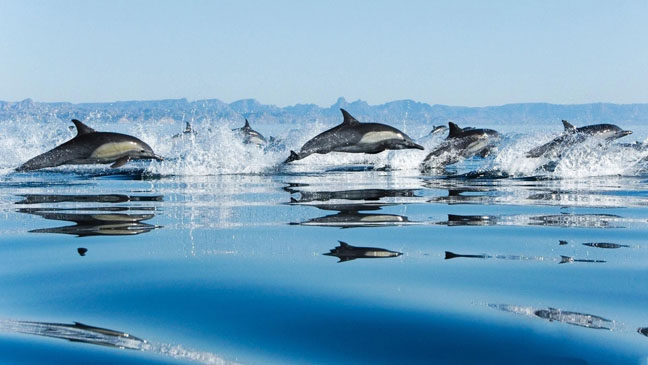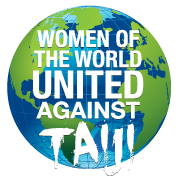Released from captivity
Springer the Orca (Seen 11 yrs after her rescue and release, 2013 with a new calf) Springer (born late 1999 or early 2000), officially named A73, is a wild orca (also known as killer whale) from the Northern Resident Community of orcas which every summer frequent the waters off the northern part of Vancouver Island, British Columbia (BC). In 2002, Springer, then a calf, was discovered alone and emaciated some 250 miles from her family's (called a pod), territory. Experts identified Springer by her vocal calls that is specific to her pod and by examining photographs of her eye patch.
They were also able determine where Springer's pod was currently located. Months of heated public debate ensued until the United States National Marine Fisheries Service(NMFS) made the decision to capture the young orca and try to reintegrate her into her pod. On June 12, 2002, Springer was captured and moved to a seapen in Manchester, Washington. On July 13, after medical treatment and rehabilitation, Springer was transported to Johnstone Strait, BC and held in a seapen at Dongchong Bay, Hanson Island and released the next day. In October, Springer was seen traveling with her pod to the open ocean. The following July, she returned to Johnstone Strait with the same orca pod.
As of 2013, Springer has been observed with her pod in Johnstone Strait, becoming the only cetacean in history to be successfully reintegrated into a wild population after human intervention. In July 2013, 11 years after her rescue, Springer was seen off the central British Columbia coast with a new calf and is considered to be a contributing member of that population.
(Source: FreeMorgan.org)Springer’s successful reintegration back into the wild was done with help of many people and the cooperation of international bodies, Governments (USA and Canada) and NGO’s (non-governmental organisations). Key advisors on the Free Morgan Foundation Expert Board, Jeff Foster, Ken Balcomb, Howard Garrett and Bob McLaughlin were involved with Springers training and rehabilitation for release back into the wild. Paul Spong and Helena Symonds of OrcaLab (left) also advised and continue to monitor Springers progress since her return to the wild. Springer’s story clearly shows that this is the path that should have been taken by those who captured Morgan in the Netherlands (i.e., the Dolfinarium Harderwjik). However, despite their failure to rehabilitate her and despite the fact that Morgan now languishes in abysmal conditions in Loro Parque , our team of experts who include wild orca experts, veterinarians and orca trainers, are confident that Morgan can still be released. Help us spread the word that Springer is a very good example of how Morgan’s rehabilitation and release should have gone. Lets make sure that Morgan’s story doesn’t become another Corky or Lolita captive orca story, where these poor individual orca have spent decades having to perform circus tricks. They will never have the chance to retire if kept in captivity in an entertainment park, as the only way captive orca ever retire is if they die.
Check out these amazing releases - dolphins, whales and more!
Proving further it is possible to release even captive born cetaceans! A List of Examples (Orca Network) Compiled by Kenneth C. Balcomb III ©1995 Center for Whale Research - Friday Harbor, WA 98250
“Over the years that dolphins have been kept in captivity, some have been released back into the wild after varying periods of time. During most of these early dolphin reintroductions, the animals were often taken from a tank and placed back in the bays close to the facilities. Some of these were display animals no longer of use to the facility. In all these cases there was no followup monitoring” (Bassos, 1993).
This document is dedicated to “Keiko,” “Junior,” “Tanouk” and “Lolita,” as well as the many smaller captive cetaceans which have been and are maintained in solitary confinement and inadequate facilities devoid of significant educational benefit to the public or conservation benefit to their species. They could be returned to the benefit of all.
For this preliminary summary, I have included anecdotal reports of releases of dolphins (including large species such as killer whales) from captivity by institutions and individuals which have maintained them in many parts of the world. I have also included a few examples of reintroductions of stranded cetaceans which provide useful background on followup documentation. But, it is not the astonishing durability and survival instinct of these animals in nature that is in question. Currently, a major point of contention in the issue of release or reinstatement of captive cetaceans is whether the dolphin or whale will readapt to catching live prey after it has been fed piecemeal in prolonged captivity. Another point of contention is whether released animals will spread acquired pathogens to the wild community, or have sufficient immunity from pathogens in the wild. And, a third point concerns the question of whether a released cetacean will readapt socially, or be condemned to a life of loneliness.
These points must be responsibly addressed; but, if post-captive release is lethal, dangerous and irresponsible, then why has it been done so many times by organizations that are generally considered responsible?
This is not intended to be an exhaustive list, and any additions or suggestions the reader can offer will be appreciated. Considering the worldwide, sometimes illegal and often unregulated trade in these animals, there undoubtedly have been other releases for institutional and business convenience which are not included herein. In the interest of proper historical documentation, I will list only those which have been published or have been reported to me firsthand by reliable sources. This does not include reports of approximately 20 dolphins that have been rehabilitated from stranding events and released back to the wild (NMFS records). It will be particularly useful in future editions of this publication to compile a list of releases of cetaceans that were examined by qualified veterinarians prior to release, and for which veterinary records (and/or specimen materials) may be available. This information, together with similarly compiled information from stranding events may yield useful epidemiological insights into the question of immunocompetence and introduction of 'captive acquired pathogens' to wild populations. The state of the art in telemetry and observational studies can in many cases reveal whether released animals fare well and are socially reinstated. Continue Reading
Keiko's Life
(Orca Network) Compiled by Howard Garrett ©1995 Anthropologists tell us that the stories we tell shape our perceptions of the world. No story about a whale, or probably about any non-human animal, has been told more than Keiko’s story, so just by virtue of repetition it is historically important as cultural myth. Keiko brings to public awareness three things, if the story is told the way it has actually happened:
An animal welfare/rights issue involving the exploitation and mistreatment of orcas and animals in general; A true story that demonstrates the immense capabilities of these marine mammals and helps correct a vast quantity of misleading information; And an opportunity for the marine mammal scientific community to demonstrate their abilities to the general public by solving the problems of returning long-term captive orcas to their native waters. Scientists have shown the public the value of their methods of photo-identification, DNA techniques, sensing and telemetry, and acoustic science. These advances in field study methods can be applied to solving problems associated with retiring captives, even captive-born orcas, to natural settings, and potentially rehabilitating them for at least partial release.
Keiko's perilous journey to freedom is also an adventure, with danger and rewards, good guys and bad guys. Much of this history is drawn from personal conversations and news reports. For ten years we've heard a drumbeat of unfounded cynicism about Keiko's prospects from park industry and media critics who are not familiar with the natural history of the species in natural settings and are not accepting factual information, some of it recently learned. This telling of Keiko's history is intended to help people learn from his example. There have been many others intimately involved in Keiko's long reintroduction process who may have other perspectives. Please contact Orca Network with any additions or corrections to this rendition of Keiko's story. Continue Reading As more information becomes available we will post it here on our Release Page.

